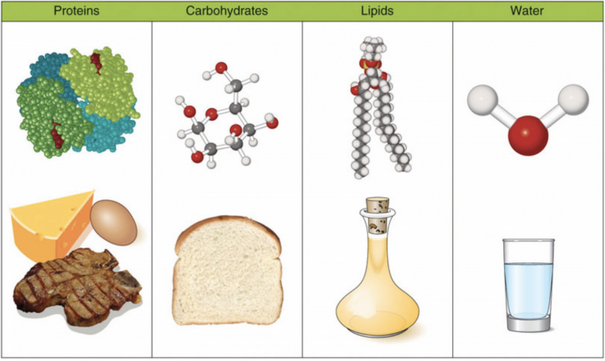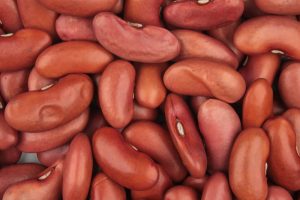Introduction
“If you’re hungry, you better eat what you know. If you’re from New Orleans and you get really hungry, you better have New Orleans food.”
– Chef Leah Chase

(Source: Wikimedia Commons, Kate, CC-BY)
Learning Objectives
By the end of this chapter, you will be able to:
- Define nutrition.
- Describe basic concepts in nutrition.
- Describe factors that affect your nutritional needs.
- Describe the importance of research and scientific methods to understanding nutrition.
- Discuss nutrition as a science.
What are Nutrients?
The foods we eat contain nutrients. Nutrients are substances required by the body to perform its basic functions. Nutrients must be obtained from our diet, since the human body does not synthesize or produce them. Nutrients have one or more of three basic functions: they provide energy, contribute to body structure, and/or regulate chemical processes in the body. These basic functions allow us to detect and respond to our environmental surroundings, move, excrete wastes, respire (breathe), grow, and reproduce. Six nutrients are required for the body to function and maintain overall health (Figure 1.1). These are carbohydrates, lipids, proteins, water, vitamins, and minerals. Foods also contain non-nutrients that may be harmful (such as natural toxins common in plant foods and additives like some dyes and preservatives) or beneficial (such as antioxidants).

Macronutrients Micronutrients
Macronutrients
Nutrients that are needed in large amounts are called macronutrients. There are three classes of macronutrients: carbohydrates, lipids, and proteins. Through various biological processes occurring in the body, these nutrients can be metabolized to produce cellular energy. The energy from macronutrients comes from their chemical bonds. This chemical energy is converted into cellular energy that is then utilized to perform work, allowing our bodies to conduct their basic functions. The energy obtained from food, and thus becomes cellular energy, is measured in calorie units. A unit of measurement of food energy is the calorie. On nutrition food labels the amount given for “calories” is actually equivalent to each calorie multiplied by one thousand. A kilocalorie (one thousand calories, denoted with a small “c”) is synonymous with the “Calorie” (with a capital “C”) on nutrition food labels. Although water does not yield calories, it is considered to be a macronutrient because it is needed in large amounts daily. Water is also a macronutrient in the sense that you require a large amount of it, but unlike the other macronutrients, it does not yield calories.
Carbohydrates
Carbohydrates are molecules composed of the elements carbon, hydrogen, and oxygen. The major food sources of carbohydrates are grains, milk, fruits, and starchy vegetables, like potatoes and rice. Non-starchy vegetables also contain carbohydrates, but in lesser quantities. Carbohydrates are broadly classified into two forms based on their chemical structure: simple carbohydrates, often called simple sugars; and complex carbohydrates.
Simple carbohydrates consist of one or two basic units. Examples of simple sugars include sucrose, the type of sugar you would have in a bowl on the breakfast table, and glucose, the type of sugar that circulates in your blood.
Complex carbohydrates are long chains of simple sugars that can be unbranched or branched. During digestion, the body breaks down digestible complex carbohydrates to simple sugars, mostly glucose. Glucose is then transported to all our cells where it is stored, used to make energy, or used to build macromolecules. Fiber is also a complex carbohydrate, but it cannot be broken down by digestive enzymes in the human intestine. As a result, it passes through the digestive tract undigested unless the bacteria that inhabit the colon or large intestine break it down.
One gram of digestible carbohydrates yields four kilocalories of energy for the cells in the body to perform work. In addition to providing energy and serving as building blocks for bigger macromolecules, carbohydrates are essential for the proper functioning of the nervous system, heart, and kidneys. As mentioned, glucose can be stored in the body for future use. In humans, the storage molecule of carbohydrates is called glycogen, and in plants, it is known as starch. Glycogen and starch are complex carbohydrates.
Lipids
Lipids are also a family of molecules composed of carbon, hydrogen, and oxygen, but unlike carbohydrates, they are insoluble in water. Lipids are found predominantly in butter, oils, meats, dairy products, nuts, and seeds, and in many processed foods. The three main types of lipids are triglycerides (triacylglycerols), phospholipids, and sterols. The main job of lipids is to provide or store energy. Lipids provide more energy per gram than carbohydrates (nine kilocalories per gram of lipids versus four kilocalories per gram of carbohydrates). In addition to energy storage, lipids serve as a major component of cell membranes, surround and protect organs (in fat-storing tissues), provide insulation to aid in temperature regulation, and regulate many other functions in the body.
Proteins
Proteins are macromolecules composed of chains of subunits called amino acids. Amino acids are simple subunits composed of carbon, oxygen, hydrogen, and nitrogen. Food sources of proteins include meats, dairy products, seafood, and a variety of different plant-based foods, most notably soy. The word protein comes from a Greek word meaning “of primary importance,” which is an apt description of these macronutrients; they are also known colloquially as the “workhorses” of life. Proteins provide four kilocalories of energy per gram; however providing energy is not protein’s most important function. Proteins provide structure to bones, muscles and skin, and play a role in conducting most of the chemical reactions that take place in the body. Scientists estimate that greater than one-hundred thousand different proteins exist within the human body. The genetic codes in DNA are basically protein recipes that determine the order in which 20 different amino acids are bound together to make thousands of specific proteins.

(Source: University of Hawaii @ Manoa, CC-BY-NC-SA)
Water
There is one other nutrient that we must have in large quantities: water. Water does not contain carbon but comprises two hydrogen atoms and one oxygen atom per water molecule. More than 60 percent of your total body weight is water. Without it, nothing could be transported in or out of the body, chemical reactions would not occur, organs would not be cushioned, and body temperature would fluctuate widely. An adult consumes just over two liters of water daily from food and drink combined. Since water is so critical for life’s basic processes, the amount of water input and output is significant, a topic we will explore in detail in Chapter 4.
Micronutrients
Micronutrients are nutrients required by the body in lesser amounts, but are still essential for carrying out bodily functions. Micronutrients include all the essential minerals and vitamins. There are sixteen essential minerals and thirteen vitamins (See Table 1.1 “Macro Minerals and Their Major Functions”, Table 1.2 “Micro Minerals and Their Major Functions”, Table 1.3 “Water-soluble Vitamins and Their Major Functions”, and Table 1.4 “Fat-soluble Vitamins and Their Major Functions” for a complete list and their major functions). In contrast to carbohydrates, lipids, and proteins, micronutrients are not sources of energy (calories), but they assist in the process as cofactors or components of enzymes (i.e., coenzymes). Enzymes are proteins that catalyze chemical reactions in the body and are involved in all aspects of body functions from producing energy, to digesting nutrients, to building macromolecules. Micronutrients play many essential roles in the body.
| Minerals | Major Functions |
|---|---|
| Sodium | Fluid balance, nerve transmission, muscle contraction |
| Chloride | Fluid balance, stomach acid production |
| Potassium | Fluid balance, nerve transmission, muscle contraction |
| Calcium | Bone and teeth health maintenance, nerve transmission, muscle contraction, blood clotting |
| Phosphorus | Bone and teeth health maintenance, acid-base balance |
| Magnesium | Protein production, nerve transmission, muscle contraction |
| Sulfur | Protein production |
| Minerals | Major Functions |
|---|---|
| Iron | Carries oxygen, assists in energy production |
| Zinc | Protein and DNA production, wound healing, growth, immune system function |
| Iodine | Thyroid hormone production, growth, metabolism |
| Selenium | Antioxidant |
| Copper | Coenzyme, iron metabolism |
| Manganese | Coenzyme |
| Fluoride | Bone and teeth health maintenance, tooth decay prevention |
| Chromium | Assists insulin in glucose metabolism |
| Molybdenum | Coenzyme |
Minerals
Minerals are solid inorganic substances that form crystals and are classified depending on how much of them we need. Trace minerals, such as molybdenum, selenium, zinc, iron, and iodine, are only required in a few milligrams or less. Macrominerals, such as calcium, magnesium, potassium, sodium, and phosphorus, are required in hundreds of milligrams. Many minerals are critical for enzyme function, others are used to maintain fluid balance, build bone tissue, synthesize hormones, transmit nerve impulses, contract and relax muscles, and protect against harmful free radicals in the body that can cause health problems such as cancer.
Vitamins
The thirteen vitamins are categorized as either water-soluble or fat-soluble. The water-soluble vitamins are vitamin C and all the B vitamins, which include thiamine, riboflavin, niacin, pantothenic acid, pyridoxine, biotin, folate and cobalamin. The fat-soluble vitamins are A, D, E, and K. Vitamins are required to perform many functions in the body such as making red blood cells, synthesizing bone tissue, and playing a role in normal vision, nervous system function, and immune system function.
| Vitamins | Major Functions |
|---|---|
| Thiamin (B1) | Coenzyme, energy metabolism assistance. |
| Riboflavin (B2 ) | Coenzyme assists energy metabolism. |
| Niacin (B3) | Coenzyme, energy metabolism assistance. |
| Pantothenic acid (B5) | Coenzyme assists energy metabolism. |
| Pyridoxine (B6) | Coenzyme, amino acid synthesis assistance. |
| Biotin (B7) | Coenzyme, amino acid, and fatty acid metabolism. |
| Folate (B9) | Coenzyme is essential for growth. |
| Cobalamin (B12) | Coenzyme, red blood cell synthesis. |
| C (ascorbic acid) | Collagen synthesis, antioxidant. |
| Vitamins | Major Functions |
|---|---|
| A | Vision, reproduction, and immune system function. |
| D | Bone and teeth health maintenance, and immune system function. |
| E | Antioxidant, cell membrane protection. |
| K | Bone and teeth health maintenance, blood clotting. |
Vitamin deficiencies can cause severe health problems and even death. For example, a deficiency in niacin causes a disease called pellagra, which was common in the early twentieth century in some parts of America. The common signs and symptoms of pellagra are known as the “4D’s—diarrhea, dermatitis, dementia, and death.” Until scientists found out that better diets relieved the signs and symptoms of pellagra, many people with the disease ended up hospitalized in insane asylums awaiting death. Other vitamins were also found to prevent certain disorders and diseases such as scurvy (vitamin C), night blindness (vitamin A), and rickets (vitamin D).
| Nutrient | Function |
|---|---|
| Protein | Necessary for tissue formation, cell repair, and hormone and enzyme production. It is essential for building strong muscles and a healthy immune system. |
| Carbohydrates | Provide a ready source of energy for the body and provide structural constituents for the formation of cells. |
| Fat | It provides stored energy for the body, functions as a structural component of cells, and is a signaling mechanism for proper cellular communication. It provides insulation to vital organs and works to maintain body temperature. |
| Vitamins | Regulate body processes and promote normal body-system functions. |
| Minerals | Regulate body processes, which are necessary for proper cellular function, and comprise body tissue. |
| Water | Transports essential nutrients to all body parts, transports waste products for disposal, and aids with body temperature maintenance. |
Practicing the Principles
It’s red beans and rice Monday in Louisiana! As the designated chef, you have been tasked with preparing a meal of red beans, rice, fried chicken, corn bread, collard greens, peach cobbler, and sweet tea. Identify which nutrient classes are found in each component of the meal.

| Item | Nutrient Class Found in Item |
|---|---|
| Red beans | |
| Rice | |
| Fried chicken | |
| Cornbread | |
| Collard greens | |
| Peach cobbler | |
| Sweet tea |
Light Bulb Questions:
How can you make this meal healthier? How can additional micronutrients be added to it?

Learning Activities
Technology Note: The Louisiana edition of the Human Nutrition Open Educational Resource (OER) textbook features interactive learning activities. These activities are available in the web-based textbook, but not in downloadable versions (EPUB, Digital PDF, Print_PDF, or Open Document).
Learning activities may be used across various mobile devices; however, for the best user experience, it is strongly recommended that users complete these activities using a desktop or laptop computer.
The capacity of a body or physical system for doing work. There are two fundamental forms: kinetic energy and potential energy.
A class of nutrients containing carbon, hydrogen, and oxygen atoms; most are commonly known as sugar, starches or dietary fibers.
A class of nutrients containing carbon, hydrogen, a little oxygen, and some other atoms. Commonly known as fats that include fatty acids, triglycerides, phospholipids, and sterols.
A class of compounds composed of linked amino acids. They contain carbon, hydrogen, nitrogen, oxygen, and sometimes other atoms in specific configurations.
The universal chemical solvent in which most of the processes of life occur.
Organic compounds that are needed in small amounts in the diet to support and regulate the chemical reactions and processes needed for growth, reproduction, and the maintenance of health.
An element used in the body to promote chemical reactions and help form body structures.
nutrients that are needed in large amounts
A fundamental unit of energy, equal to 4.1855 joule; 1000 calories equals 1 kcal.
The sum of all processes involved in how organisms obtain nutrients, metabolize them, and use them to support all of life’s processes.
The standard unit of energy used in nutrition; the amount of heat required to raise temperature of 1 kg water 1℃ .
Essential nutrients that are needed by the body in large amounts
Carbohydrates known as sugars that contain monosaccharides and disaccharides.
Carbohydrates known as large sugar molecules linked together in straight or branching chains that include oligosaccharides, starches and fibers.
A disaccharide made of glucose linked to fructose and commonly known as table sugar.
A 6-carbon monosaccharide that is the major carbohydrate used to provide energy in the body.
molecules containing very large numbers of atoms
A type of carbohydrate that is indigestible and cannot be broken down by human digestive enzymes.
A protein molecule that speeds up or accelerates specific chemical reactions without changing itself.
The storage form of a complex carbohydrate composed of multiple units of glucose linked together in a highly branched structure.
A complex carbohydrate that is found in plants and made up of glucose molecules linked together in a straight or branched structure.
a type of fat, called lipid , that circulate in your blood; the most common type of fat in your body
phosphorus-containing complex lipids (such as lecithins and phosphatidylethanolamines) that are derived from glycerol and are major constituents of the membranes of cells and intracellular organelles and vesicles
Multiring molecules that occurs in the membranes of plants, animals, and microorganisms
The molecules from which proteins are built, each protein being composed of a specific sequence of linked amino acids.
A substance in food that can provide energy, contribute to body structure, and/or regulate body processes.
Essential nutrients that are needed by the body in small amounts. These include vitamins and minerals.
Chemicals required for enzymes to perform their acts of catalysts.
Chemical groups that bind to enzymes and assist in enzymatic catalysis.
An essential mineral required in the diet in an amount of 100 mg per day or less.
Minerals present in the body at concentrations of more than 50 ppm or 0.005% of body weight.
The major structural and supportive connective tissue of the body.
A chemical messenger in the body that is released into the blood from one specific location in the body and travels to another location, where it elicits a specific response.
A highly reactive atom or molecule that causes oxidative damage.
a vitamin of the vitamin B complex that is essential to normal metabolism and nerve function and is widespread in plants and animals; also called vitamin B1
A B vitamin that is needed for energy metabolism.
A B vitamin that is needed for energy metabolism.
One of the B vitamins needed for energy metabolism.
A B vitamin that is needed for energy metabolism.
A B vitamin that is needed for the synthesis of DNA and the metabolism of some amino acids.
any of a group of cobalt-containing substances including cyanocobalamin (vitamin B12)
A disease caused by niacin deficiency, characterized by inflammation of the skin, diarrhea, and eventually mental incapacity.
condition of the skin in which it becomes red, swollen, and sore, sometimes with small blisters, resulting from direct irritation of the skin by an external agent or an allergic reaction to it
The deterioration of an individual’s mental state that results in impaired memory, thinking, and judgement.
A disease caused by a vitamin C deficiency characterized by bleeding gums, tooth loss, joint pain, bleeding into the skin and mucous membrane, and fatigue.
A condition due to a deficiency in vitamin A where the eye recovers very slowly from exposure to bright light.
A disease that is characterized by softening of the bones due to poor calcium deposition within them because of a lack of vitamin D in the body.


